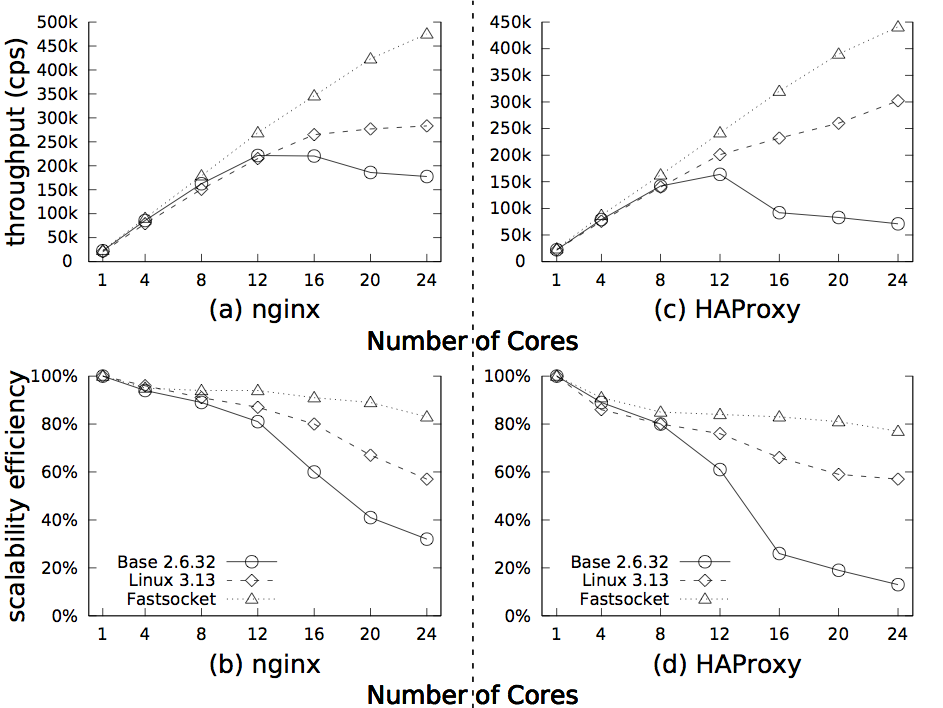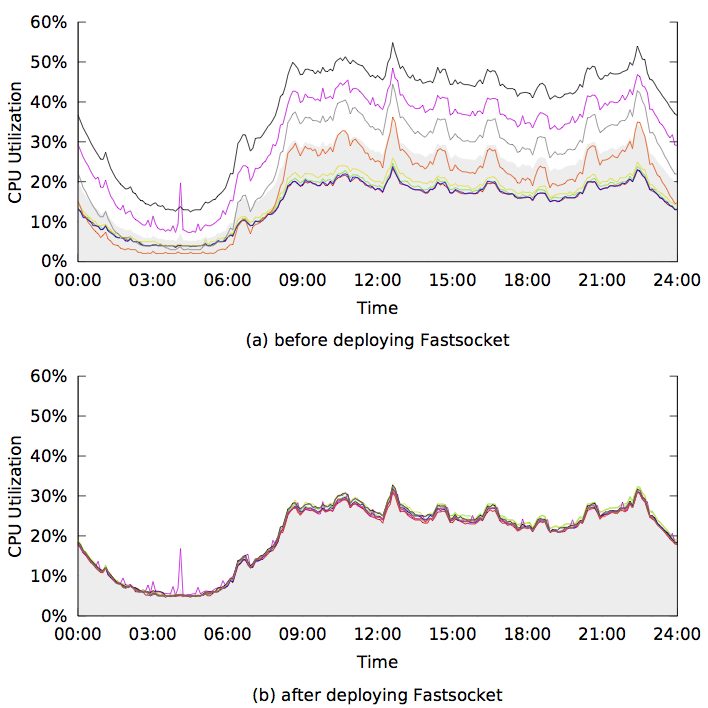- Introduction
- Participants
- Installation
- System Configuration
- Usage
- Suitable Scenarios
- [How To Use] (#how-to-use)
- Demo Server
- Evaluation
- [Nginx] (#nginx)
- [Haproxy] (#haproxy)
- Online Evaluation
With a rapid growth of NIC bandwidth and CPU cores on one single machine, a scalable TCP network stack is performance-critical. However, stock Linux kernel dose not scale well when CPU core number is above 4. It is even worse that the throughput could collapse when there are more than 12 CPU cores.
Fastsocket is a scalable TCP socket implementation and achieves a straight linear performance growth when scaling up to 24 CPU cores. To realize the scalability, Fastsocket
- removes socket performance bottlenecks in the VFS,
- achieves locality of both passive and active connections,
- converts both listen and established socket tables into per-cpu data structures,
- benefits applications without introducing modifications to the applications, and
- keeps all kinds of monitoring/tuning tools available out-of-the-box.
Fastsocket is released under GPLv2 and currently implemented in the Linux kernel(kernel-2.6.32-431.17.1.el6) of CentOS-6.5.
According to our evaluations, Fastsocket increases throughput of Nginx and Haproxy(measured by connections per second) by 290% and 620% on a 24-core machine, compared to the base CentOS-6.5 kernel.
Moreover, Fastsocket can further exploit more from the hardware:
- With Fastsocket, Hyper-Threading can make an extra 20% performance increase.
- With Fastsocket, NIC that support Flow-Director(like Intel 82599) can increase the throughput by 15% if the server works as a proxy(like Haproxy).
Fastsocket has already been deployed in the SINA production environment and is used with Haproxy to provide HTTP load balance service. More details are in the Evaluation.
- Fastsocket is started and mainly developed by Xiaofeng Lin from the OS team of SINA.COM.
- OS center of Tsinghua is cooperating closely with SINA.COM to further enhance Fastsocket.
- Fastsocket is also supported by Intel with extensive assistance.
- Zeuux Community is providing open source consulting for Fastsocket.
The source code is available at https://github.com/fastos/fastsocket.git. Clone the repository by:
[root@localhost ~]# git clone https://github.com/fastos/fastsocket.git
Here is a brief introduction to the directories in the repository.
- kernel - source code of the Fastsocket customized kernel
- module - source code of the Fastsocket kernel module
- library - source code of user-level library to support Fastsocket
- scripts - scripts to set NIC and system environment(NOT compulsory for Fastsocket)
- demo - source code of a demo server to demonstrate performance of Fastsocket
The following commands will build and install the kernel after Fastsocket repository is downloaded from git.
[root@localhost ~]# cd fastsocket/kernel
[root@localhost kernel]# make defconfig
[root@localhost kernel]# make
[root@localhost kernel]# make modules_install
[root@localhost kernel]# make install
Enter the library directory and make the library:
[root@localhost fastsocket]# cd library
[root@localhost library]# make
After that, libfsocket.so is created in the same directory.
For those who do not want to bother with the source codes, RPM packages for x86_64 are provided at http://114.215.138.161/download/
Install the RPM packages:
[root@localhost ~]# rpm --force -ivh \
> kernel-2.6.32-431.17.1.el6.x86_64.rpm \
> kernel-firmware-2.6.32-431.17.1.el6.x86_64.rpm \
> kernel-devel-2.6.32-431.17.1.el6.x86_64.rpm
The library RPM package for x86_64 is also available at http://114.215.138.161/download/
Install the RPM package:
[root@localhost ~]# rpm -ivh libfsocket-1.x.x.x86_64.rpm
After that, libfsocket.so should be located in /usr/lib64.
When the installation is done, remember to modify grub file to switch to the Fastsocket kernel and reboot the system.
After booting into the kernel with Fastsocket, load the Fastsocket module with default parameters:
[root@localhost ~]# modprobe fastsocket
For more detailed information of modules parameters, please refer to Module.
Two ways to check if the module is loaded successfully.
-
Check lsmod:
[root@localhost ~]# lsmod | grep fastsocket fastsocket 23145 0 -
Check dmesg:
[root@localhost ~]# dmesg | tail Fastsocket: Load Module Fastsocket: Enable Listen Spawn[Mode-2] Fastsocket: Enable Recieve Flow Deliver Fastsocket: Enable Fast Epoll
Run nic.sh provided in the scripts directory of the repository to take care of remaining configuration.
[root@localhost ~]# cd fastsocket
[root@localhost fastsocket]# scripts/nic.sh -i eth0
eth0 is the interface to be used and should be changed according to your system configuration. The script will automatically check system and NIC parameters, then configures various features.
If you are interested in how nic.sh works, please refer to Scripts.
Generally, scenarios meeting the following conditions will benefit the most from Fastsocket:
- The machine has no less than 8 CPU cores.
- Large portion of the CPU cycles is spent in network softirq and socket related system calls.
- Short TCP connections are heavily used.
- Application uses non-blocking IO over epoll as the IO framework.
- Application uses multiple processes to accept connections individually.
Meanwhile, we are developing Fastsocket to improve the network stack performance in more general scenarios.
Fastsocket is enabled by preloading a shared library named libfsocket.so when launching an application. For example, ngnix can be started with Fastsocket by:
[root@localhost fastsocket]# cd library
[root@localhost library]# LD_PRELOAD=./libfsocket.so nginx
Without the preloaded library, applications can run as if they are on the original kernel.
[root@localhost ~]# nginx
For more information about the library, please refer to Library.
Here we list a few applications that are working fine with Fastsocket:
- haproxy
- nginx (Do disable accept mutex)
- lighttpd
We are also using Fastsocket on the load generators in our benchmark tests. This is very helpful since Fastsocket greatly increases the maximum work load that could be generated from a single machine, which saves machines and operations. These load generators are:
- ab
- http_load
We provide a demo server In the demo directory of the repository. The demo server dose nothing but read/write messages from/to network sockets and is purely used to study and benchmark the performance of network stack of Linux kernel. When the demo server is running, it has little user CPU consumption, which makes it a perfect network application to observe the network stack performance.
Moreover, it is also used to demonstrate the scalability and performance improvement of Fastsocket over the base Linux kernel.
For more information about the demo server, please refer to Demo.
Some important configurations:
- Worker number is set to the number of CPU cores.
- HTTP Keep-alive is disabled on Nginx for a short connection test.
- Http_load fetches a 64 bytes static file from Nginx with a concurrency of 500 multiplied by the number of cores.
- We enable memory cache for that static file in order to rule out any disk affection.
- accept mutex is disabled.
Note: DO DISABLE accept_mutex! With default Fastsocket module parameters, Fastsocket has partioned listen socket, therefore, there is no need to force user to accept connections one by one.
From the figure below, Fastsocket on Linux 2.6.32 achieves 470K connection per second and 83% efficiency up to 24 cores, while performance of base 2.6.32 kernel increases non-linearly up to 12 cores and drops dramatically to 159K with 24 cores. The latest 3.13 kernel doubles the throughput to 283K when using 24 cores compared with 2.6.32. However, it has not completely solve the scalability bottlenecks, preventing performance from growing when more than 12 cores are used.
Some important configurations:
- Worker number is set to the number of CPU cores.
- RFD(Receive Flow Deliver) in Fastsocket is enabled.
- HTTP Keep-alive is disabled on Haproxy for a short connection test.
- A client runs http_load with a concurrency of 500 multiplied by number of cores.
- A backend server responds each incoming HTTP request with a 64 bytes message.
As shown in the same Figure, Fastsocket presents a exellent scalability performance, which is very similar to the previous nginx case. Fastsocket outperforms Linux 3.13 by 14K connection per second and base 2.6.32 by 37K when using 24 cores, though the one core throughputs are very close among all the three kernels.
As mentioned before, Fastsocket has already been deployed in the SINA production environment. One typical scenario is using Fastsocket with Haproxy to provide HTTP load balance service to WEIBO and other SINA productions.
In the figure below, it is the CPU utilization of a 8-core servers within 24 hours. Figure (a) shows the CPU utilization before deploying Fastsocket and figure (b) shows the CPU utilization after deploying Fastsocket.
We can see from the figure, what happened after Fastsocket is used:
- The load of each CPU core is perfect balanced.
- The average CPU utilization of all CPU cores is reduced by 10%.
- As a result, the effective capacity of the Haproxy server is increased by 85%.
Moreover, since the server is an old 8-core machine, we expect Fastsocket would make more performance improvement when Fastsocket is deployed on a machine with more CPU cores.

